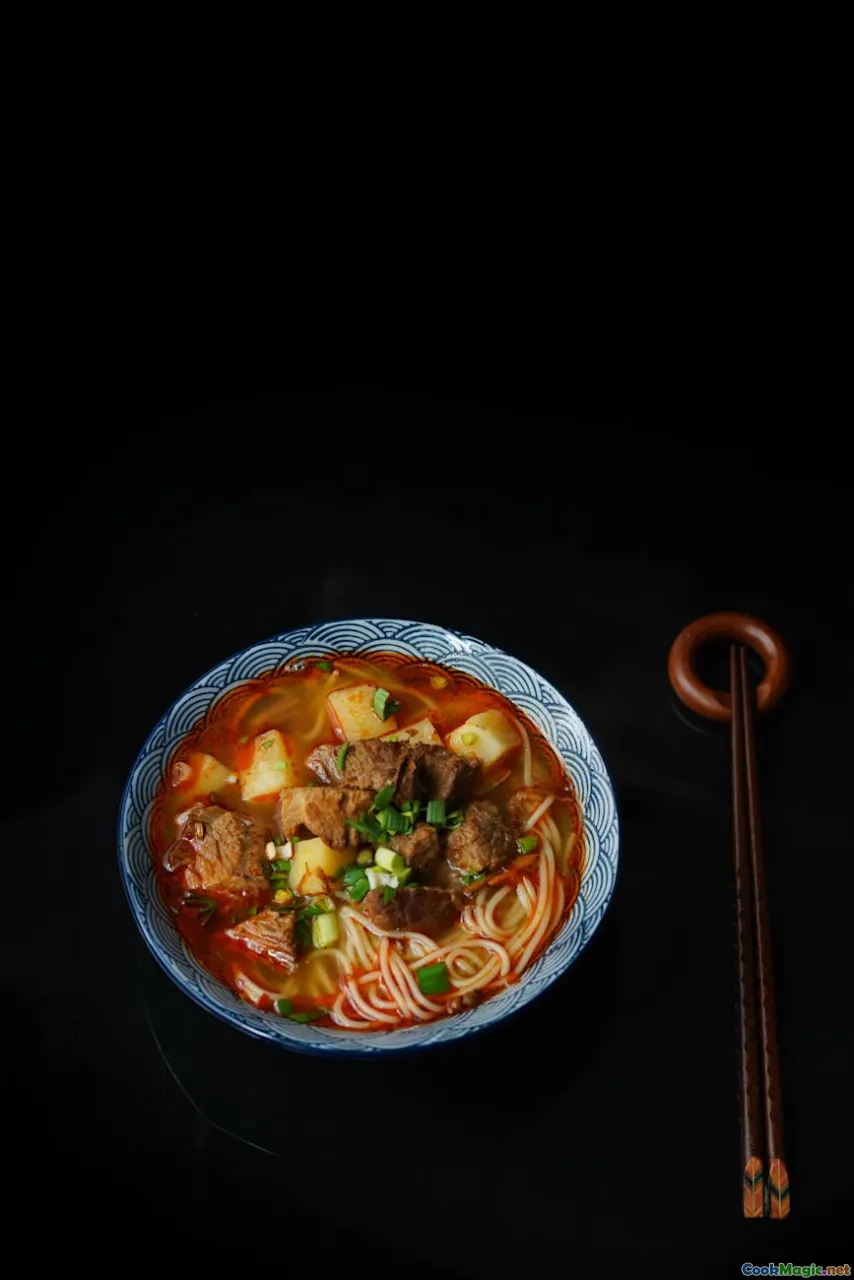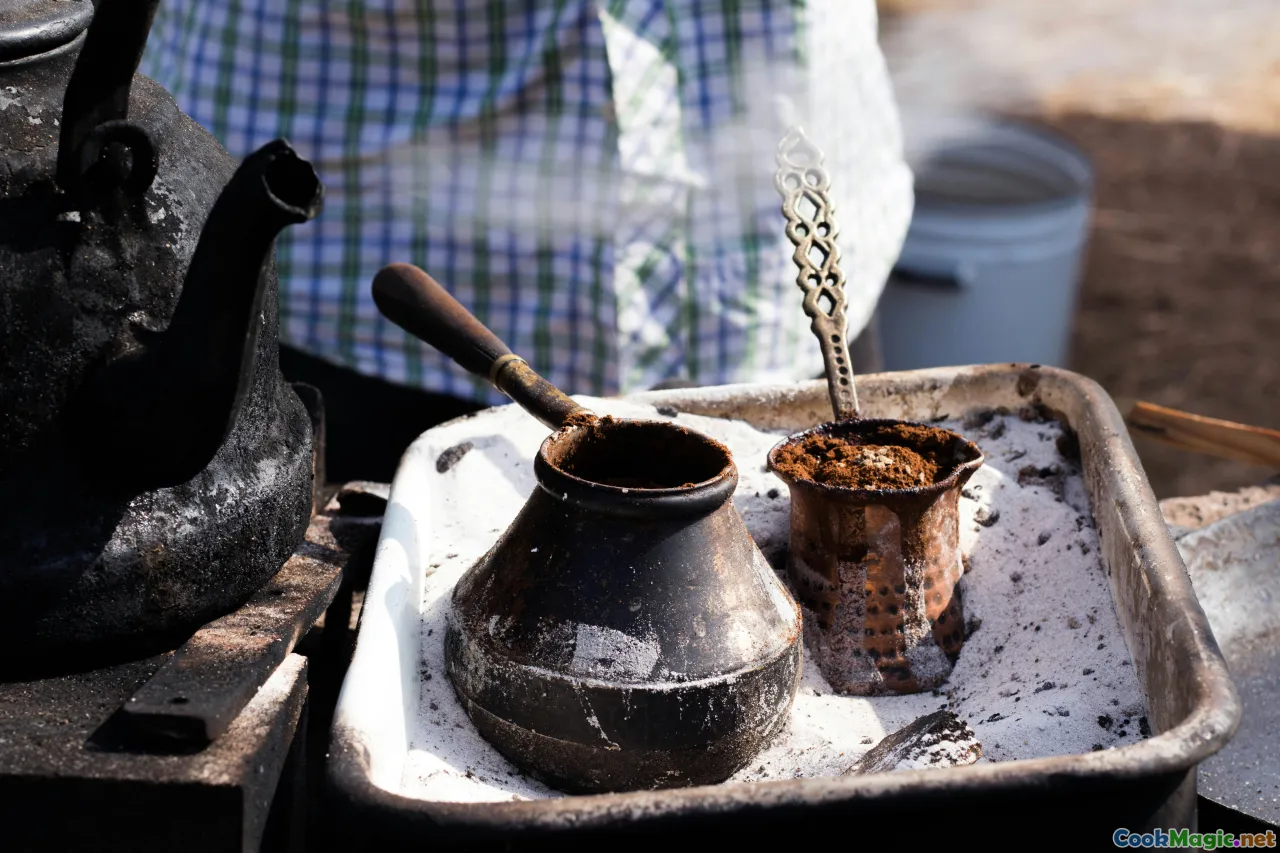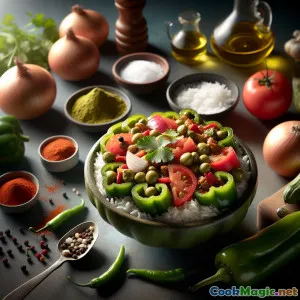
شوربة قدم السلفادورية بالأعشاب العطرية لاحتساء مليء بالروح
(Herbaceous Salvadoran Sopa de Pata for Soulful Sipping)
(0 المراجعات)0
2,386
أغسطس 14, 2025
الإبلاغ عن مشكلة
المكونات
-
1.2 kg قدمي البقر (pata de res)
(Chopped into bite-size pieces, cleaned thoroughly)
-
350 grams الكسافا (Yuca)
(Peeled and cut into thick chunks)
موز أخضر, 1
-
2 ears ذرة على السيقان
(Sliced into 3cm pieces)
-
2 large الجزر
(Peeled and thickly sliced)
-
1 medium قرع الشايوتي
( مقشر ومقطع إلى مكعبات)
-
1 large بصل
(مقسم إلى أرباع)
-
6 cloves فصوص الثوم
(Peeled and lightly crushed)
أوراق الغار, 2
-
10 sprigs نعناع (hierbabuena)
(طازج، بالإضافة إلى كمية إضافية للتزيين)
-
1 tsp أوريغانو
(مجفف)
-
20 grams الكزبرة
(مفروم، بالإضافة إلى كمية إضافية للتزيين)
الفلفل الحلو, 2
-
1 large طماطم
(مفروم)
-
2 tsp ملح
(حسب الذوق)
-
1 tsp فلفل أسود
(مطحون طازج، حسب الذوق)
-
3.5 liters ماء
شرائح الليمون الأخضر, 6
-
2 tbsp بصل أخضر مفروم
(زينة)
(Chopped into bite-size pieces, cleaned thoroughly)
(Peeled and cut into thick chunks)
(Sliced into 3cm pieces)
(Peeled and thickly sliced)
( مقشر ومقطع إلى مكعبات)
(مقسم إلى أرباع)
(Peeled and lightly crushed)
(طازج، بالإضافة إلى كمية إضافية للتزيين)
(مجفف)
(مفروم، بالإضافة إلى كمية إضافية للتزيين)
(مفروم)
(حسب الذوق)
(مطحون طازج، حسب الذوق)
(زينة)
التغذية
- الحصص: 6
- حجم الحصة: وعاء واحد (350 مل)
- Calories: 550 kcal
- Carbohydrates: 48 g
- Protein: 36 g
- Fat: 23 g
- Fiber: 6 g
- Sugar: 4 g
- Sodium: 940 mg
- Cholesterol: 190 mg
- Calcium: 98 mg
- Iron: 4.2 mg
التعليمات
-
1 - Prepare and Clean the Beef Feet:
Thoroughly wash and scrub the beef feet pieces, removing any tiny hair and residue. Rinse with water and optional lime juice, and drain.
-
2 - Start the Broth:
In a large stockpot, add cleaned beef feet and cover with 3.5 liters of water. Add onion, garlic, bay leaves, and dried oregano.
-
3 - Simmer Slowly:
Bring to a boil, then lower the heat. Skim off any impurities or foam that rise to the surface, and simmer for 2.5 hours, partially covered.
-
4 - Add Hearty Vegetables:
Add the cassava, plantain, corn, carrots, chayote squash, and sweet peppers. Stir in chopped tomato and continue to simmer until vegetables are cooked through but firm, about 20 minutes.
-
5 - Aromatics and Final Cooking:
Season with salt and black pepper. Stir in mint sprigs and cilantro. Simmer another 10-15 minutes, allowing the herbs to infuse the soup.
-
6 - Garnish and Serve:
Remove herb sprigs, adjust seasoning. Ladle soup into bowls, ensuring both broth and ample chunks R
of vegetables and beef feet per serving. Scatter with fresh mint and scallion, serve lime wedges on the side.
Thoroughly wash and scrub the beef feet pieces, removing any tiny hair and residue. Rinse with water and optional lime juice, and drain.
In a large stockpot, add cleaned beef feet and cover with 3.5 liters of water. Add onion, garlic, bay leaves, and dried oregano.
Bring to a boil, then lower the heat. Skim off any impurities or foam that rise to the surface, and simmer for 2.5 hours, partially covered.
Add the cassava, plantain, corn, carrots, chayote squash, and sweet peppers. Stir in chopped tomato and continue to simmer until vegetables are cooked through but firm, about 20 minutes.
Season with salt and black pepper. Stir in mint sprigs and cilantro. Simmer another 10-15 minutes, allowing the herbs to infuse the soup.
Remove herb sprigs, adjust seasoning. Ladle soup into bowls, ensuring both broth and ample chunks R of vegetables and beef feet per serving. Scatter with fresh mint and scallion, serve lime wedges on the side.
المزيد عن : شوربة قدم السلفادورية بالأعشاب العطرية لاحتساء مليء بالروح
Sopa de Pata con Hierbas de Olor: Tradition, Soul, and a Symphony of Herbs
Sopa de Pata con Hierbas de Olor is more than a hearty soup—it is part of the rich culinary tradition of El Salvador and a profound emblem of Central America’s deep appreciation for every part of the animal. The translation—"soup of beef feet with fragrant herbs"—tells you almost everything: it celebrates lesser-used cuts, intelligent thrift, community gathering, slow-simmered broths, and the invigorating power fresh herbs can bring to a dish.
Historical and Cultural Context
In many cultures, offal-based soups and stews tell of resourcefulness and tough times outlasting tough cuts, but in El Salvador, sopa de pata is also a celebration. Served at family gatherings, festivals, fairs, and even on weekends stretching long over conversation, it is simultaneously festive and grounding. Cooking beef feet is a method passed down generations—turning taut, collagen-rich cuts into impossibly silky, gelatinous broth sometimes left to cook overnight or much of the day while families chat, play, and await feasting together.
Beyond its foundation (pata or beef feet), the aromatic additions are what make each rendition memorable. "Hierbas de olor" translates literally as "fragrant herbs", and families fiercely defend secret blends of greens. Mint (called ‘hierbabuena’) is essential, sometimes with epazote, cilantro, and oregano. These herbs do more than flavor—they cut the richness and potent aroma of beef feet, adding lift and finishing verdancy.
Unique Aspects
What sets this recipe apart is the generous use of multiple hefty vegetables. You will find luscious, starchy yuca (cassava), rounds of slightly sweet plantain, fresh ears of corn, and slices of chayote or other squashes giving diversity and body to each spoonful. Notably, this soup demands a very slow cook—three hours at least—to break down the tough collagen of beef feet, extracting its considerable depth into the silky, almost stew-thick broth.
Another singular point is the classic toppings: after laboring over the simmer, Salvadorans garnish with more of those herbs, slivers of spring onion, and wedges of freshly cut lime (to squeeze according to taste), dialing up brightness and inviting guests to season their bowls personally.
Modern Thoughts & How to Serve
If you’ve never made soup with collagen-rich beef feet, you’re in for a treat—besides their famous silkiness, they impart nutrients seldom found in leaner cuts. Don’t rush the cleaning step or the simmer—give the pata time, watch as the house slowly fills with delicious anticipation. If you wish to modernize, you might try a pressure cooker to shave time, though the traditional slow pot yields subtle nuances. For authenticity, always collaborate with heaps of fragrant herb sprigs during the last moments of cooking.
Some families add tripe (honeycomb stomach) or use both pork and beef; feel free to experiment. Chopping up crispy radish or ringing lime over the bowls grants sharp contrast. This is a bold, rustic dish meant for sharing—it goes beautifully with corn tortillas or fresh bread as a hearty companion.
Final Notes & Tips
- Trim all fat and stray hairs from beef feet—quality and cleanliness enhance the soup’s flavor and texture.
- If mint is hard to find, substitute with a blend of parsley and basil, but know the dish pivots on authentic hierbabuena.
- The combination of starchy yuca and plantain is essential—don’t skip these for best texture.
- For an extra layer, serve with Salvadoran curtido (pickled cabbage slaw) beside.
Sopa de Pata con Hierbas de Olor is slow, cozy, and demands patience—but it brings deep, primal comfort. Every ingredient speaks to agrarian roots, resourcefulness, and the ceaseless creativity underlying Central American kitchens. Celebrate it!
























